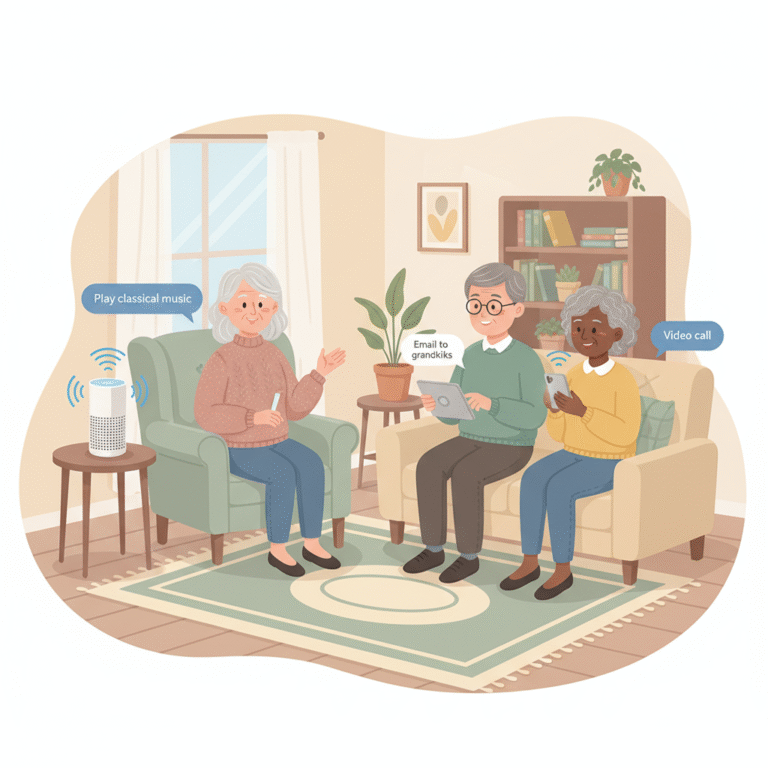Talking to AI is easier than you might think! Whether you prefer speaking aloud or typing, artificial intelligence can understand you and provide helpful answers. This guide will show you how to have conversations with AI using simple, everyday language – no technical skills required.
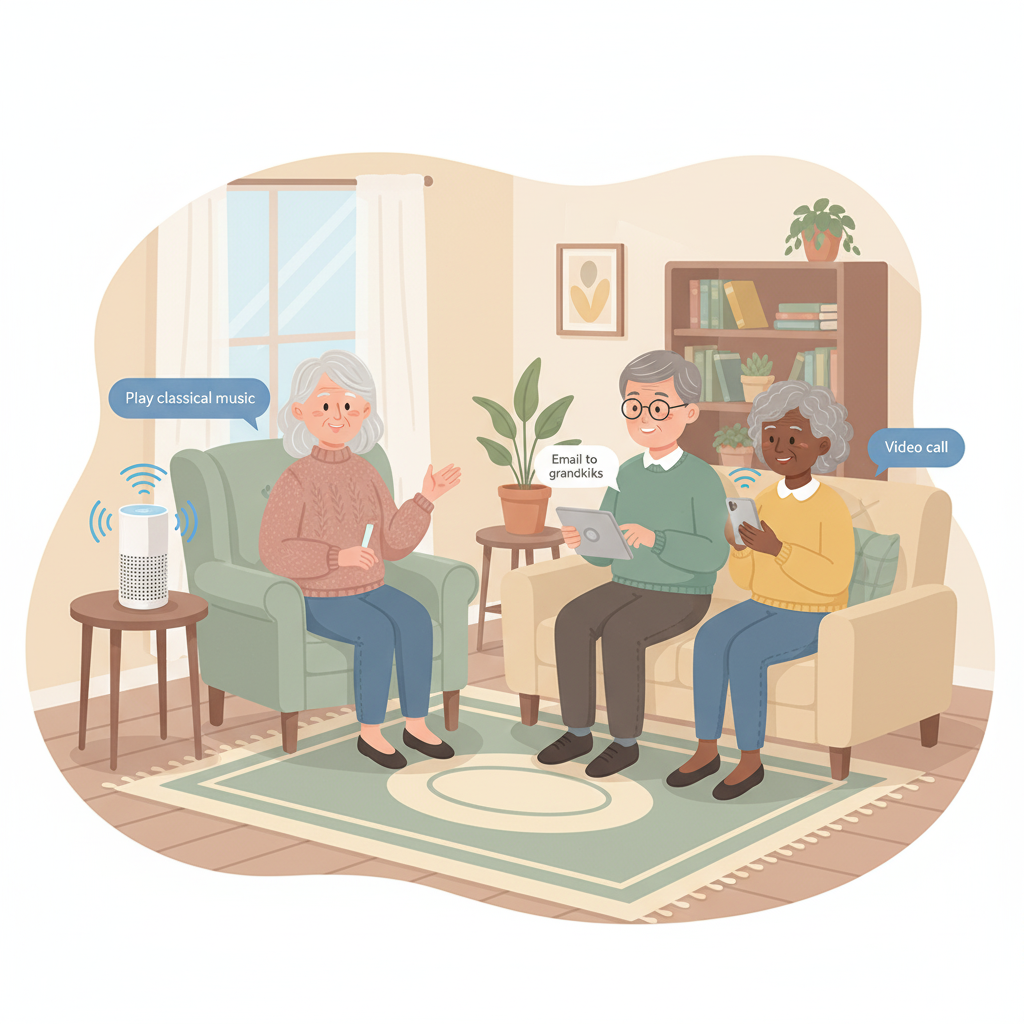
Two Easy Ways to Talk with AI
There are two simple methods to communicate with AI, and you can choose the one that feels most comfortable for you:
🎤 Voice Assistants
Speak out loud to devices that listen and respond
- Amazon Alexa (“Alexa…”)
- Google Assistant (“Hey Google…”)
- Apple Siri (“Hey Siri…”)
⌨️ Chatbots
Type your questions like sending a text message
- Google Gemini (free)
- ChatGPT (free version available)
- Microsoft Copilot (free)
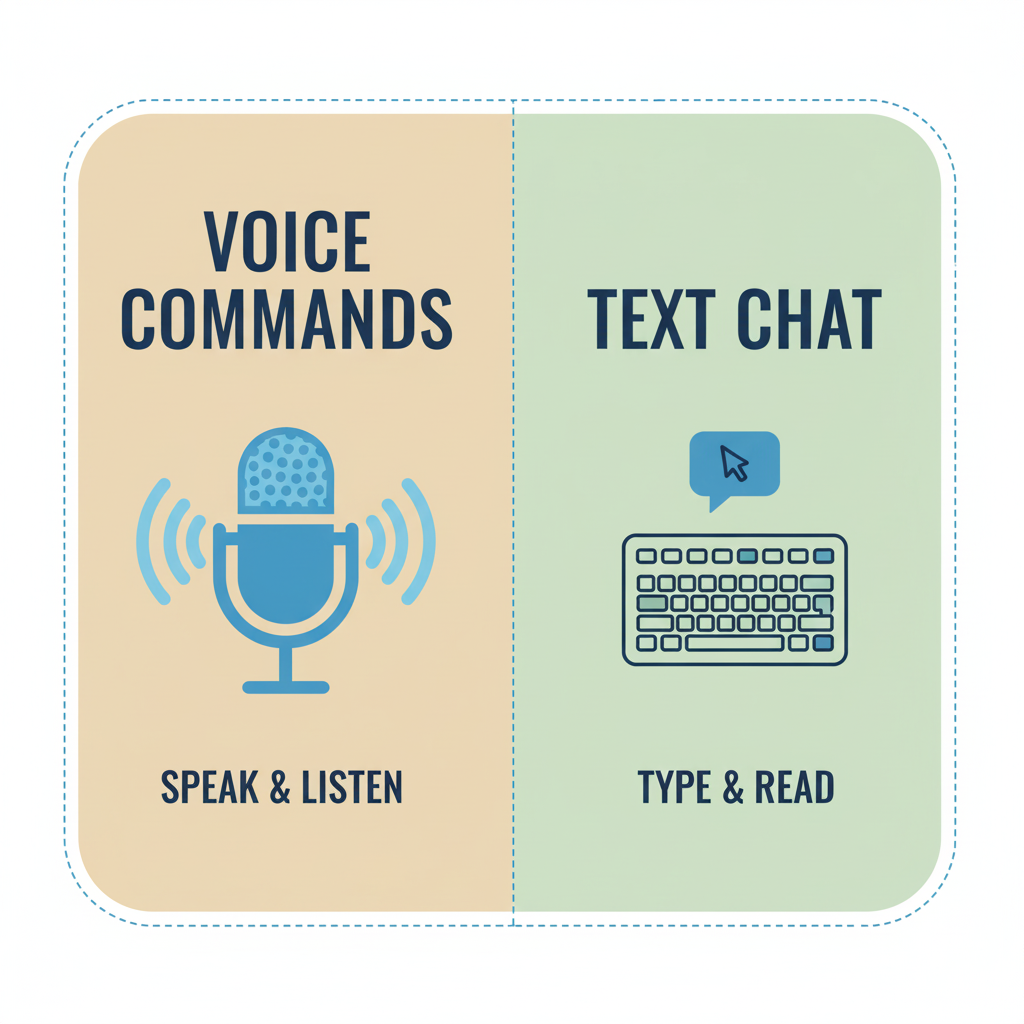
Getting Started with Voice Assistants
Voice assistants are perfect if you prefer speaking rather than typing. Here’s how to start:
Step 1: Wake Up Your Assistant
Say the “wake word” clearly:
“Alexa” – for Amazon Echo devices
“Hey Google” – for Google Nest and smartphones
“Hey Siri” – for Apple devices
Step 2: Ask Your Question Naturally
Speak clearly, but don’t worry about perfect grammar. AI understands normal conversation!
Instead of: “What is the current weather conditions?”
Say naturally: “What’s the weather like today?”
Step 3: Wait for the Response
The AI will answer you in a friendly voice. If you didn’t understand, simply say “Can you repeat that?” or “Can you explain that differently?”
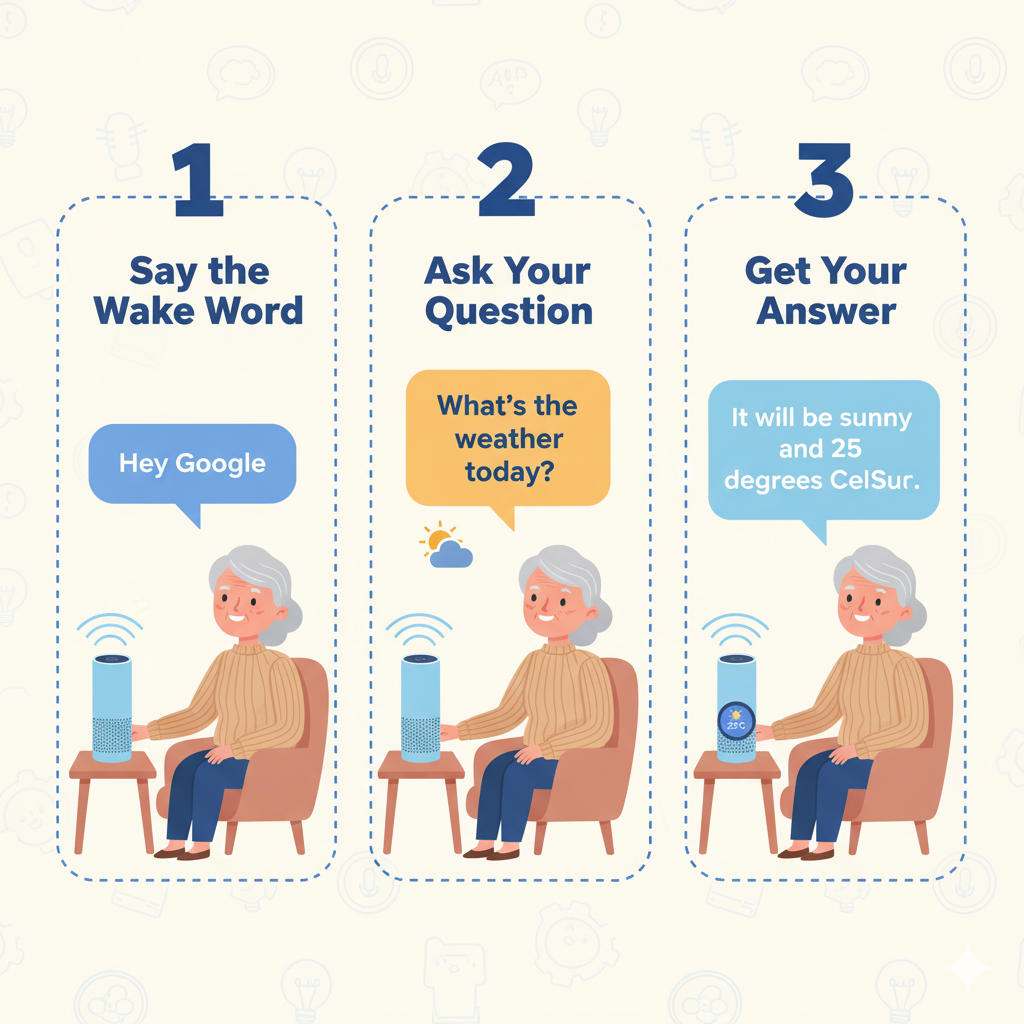
Getting Started with AI Chatbots
If you prefer typing, chatbots are wonderful companions. They work like having a helpful pen pal who knows almost everything!
Step 1: Visit a Chatbot Website
Open your web browser and go to one of these free sites:
- Google Gemini: gemini.google.com
- ChatGPT: chat.openai.com
- Microsoft Copilot: bing.com/chat
Step 2: Type Your Question
Click in the text box and type anything you’d like to know. Don’t worry about perfect spelling – AI is very understanding!
Great first questions:
“Can you help me write a friendly email to my doctor?”
“What are some easy exercises for seniors?”
“How do I make my text larger on this screen?”
Step 3: Read the Response
The AI will type back a helpful answer. If you want more information, just type “Can you tell me more?” or “Can you explain that differently?”
Practice Conversations with AI
Here are some wonderful ways to practice talking with AI. Try these today!
🌤️ Daily Help
“What’s the weather forecast for this weekend?”
“Remind me to take my medication at 2 PM”
“What’s a good recipe for chicken dinner?”
📚 Learning
“Explain how video calls work in simple terms”
“What was popular music in the 1960s?”
“Tell me about the history of my hometown”
💝 Personal
“Help me write a birthday card to my granddaughter”
“Suggest some conversation starters for family calls”
“What are some good books for seniors?”
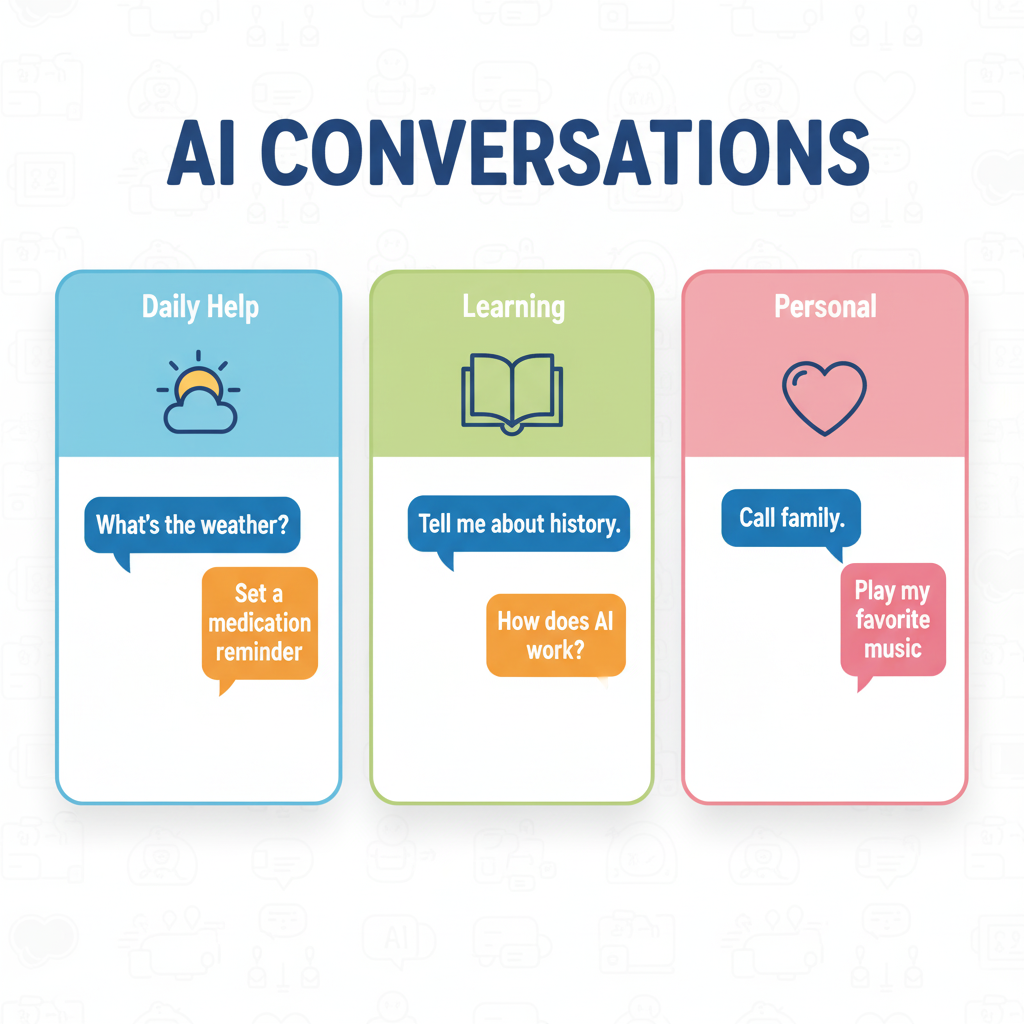
Tips for Better AI Conversations
🎯 Be Specific
Instead of “What’s the weather?” try “What’s the weather in Chicago today?”
🗣️ Speak Naturally
Use your normal speaking voice – no need for special commands
🔄 Ask Follow-ups
If the answer isn’t clear, say “Can you explain that differently?”
⏱️ Be Patient
AI sometimes takes a moment to think before answering
Frequently Asked Questions
What if the AI doesn’t understand me?
Simply rephrase your question using different words. For example, if “What’s the forecast?” doesn’t work, try “What will the weather be like today?” AI is flexible and will try to understand different ways of asking.
Is it safe to share personal information with AI?
Only share general information. Never give AI your Social Security number, credit card details, or passwords. It’s fine to ask about medical symptoms generally, but for specific advice, always consult your doctor.
Can I use AI on my existing devices?
Yes! Most smartphones, tablets, and computers made in the last 5 years can run AI assistants. Smart speakers like Amazon Echo or Google Nest are also very affordable and designed specifically for voice commands.
What’s the difference between voice assistants and chatbots?
Voice assistants are better for quick questions and home control (“turn on lights”), while chatbots are better for longer conversations and writing help. Both are helpful – choose what feels most comfortable!
You’re Ready to Start Talking with AI!
The most important thing to remember is that AI is designed to be helpful and understanding. It won’t get frustrated if you make mistakes, and it’s always ready to try again with different words.
Start small – try asking about the weather or setting a timer. As you build confidence, you’ll discover how AI can become a valuable helper for information, reminders, and even companionship.
Have questions about talking with AI? Contact us – we’re always happy to help you get started!
.article-intro {
background: #f0f7ff;
padding: 25px;
border-left: 4px solid #2c5aa0;
margin: 20px 0;
font-size: 18px;
border-radius: 8px;
}
.image-placeholder {
background: #f8f9fa;
padding: 20px;
margin: 25px 0;
border-radius: 8px;
border-left: 4px solid #E67E22;
}
.image-placeholder p {
margin: 5px 0;
color: #666;
}
.method-cards {
display: flex;
gap: 20px;
margin: 25px 0;
flex-wrap: wrap;
}
.card {
flex: 1;
min-width: 250px;
background: white;
padding: 25px;
border-radius: 10px;
border: 2px solid #e0e0e0;
border-top: 6px solid #E67E22;
}
.step-by-step {
margin: 30px 0;
}
.step {
background: white;
padding: 25px;
margin: 20px 0;
border: 2px solid #e0e0e0;
border-radius: 10px;
border-left: 6px solid #2c5aa0;
}
.voice-commands {
background: #e8f5e9;
padding: 15px;
border-radius: 5px;
margin: 15px 0;
}
.example-box {
background: #fff3e0;
padding: 15px;
border-radius: 5px;
margin: 15px 0;
border-left: 4px solid #FF9800;
}
.practice-grid {
display: grid;
grid-template-columns: repeat(auto-fit, minmax(250px, 1fr));
gap: 20px;
margin: 25px 0;
}
.practice-card {
background: white;
padding: 20px;
border-radius: 8px;
border: 1px solid #e0e0e0;
border-top: 4px solid #E67E22;
}
.tips-section {
display: grid;
grid-template-columns: repeat(auto-fit, minmax(200px, 1fr));
gap: 15px;
margin: 25px 0;
}
.tip {
background: #e3f2fd;
padding: 20px;
border-radius: 8px;
text-align: center;
}
.faq-section {
margin: 30px 0;
}
.faq-item {
margin: 20px 0;
padding: 25px;
background: #f8f9fa;
border-radius: 8px;
}
.faq-item h3 {
color: #2c5aa0;
margin-top: 0;
}
.conclusion {
background: #e3f2fd;
padding: 30px;
border-radius: 8px;
margin: 30px 0;
font-size: 18px;
}
h2 {
color: #2c5aa0;
border-bottom: 2px solid #f0f0f0;
padding-bottom: 10px;
margin-top: 40px;
}
h3, h4 {
color: #2c5aa0;
}
strong {
color: #2c5aa0;
}
/* Senior-friendly typography */
p, li {
font-size: 17px;
line-height: 1.6;
}
ul {
line-height: 1.8;
}
@media (max-width: 768px) {
.method-cards, .practice-grid, .tips-section {
grid-template-columns: 1fr;
}
.card {
min-width: auto;
}
}

